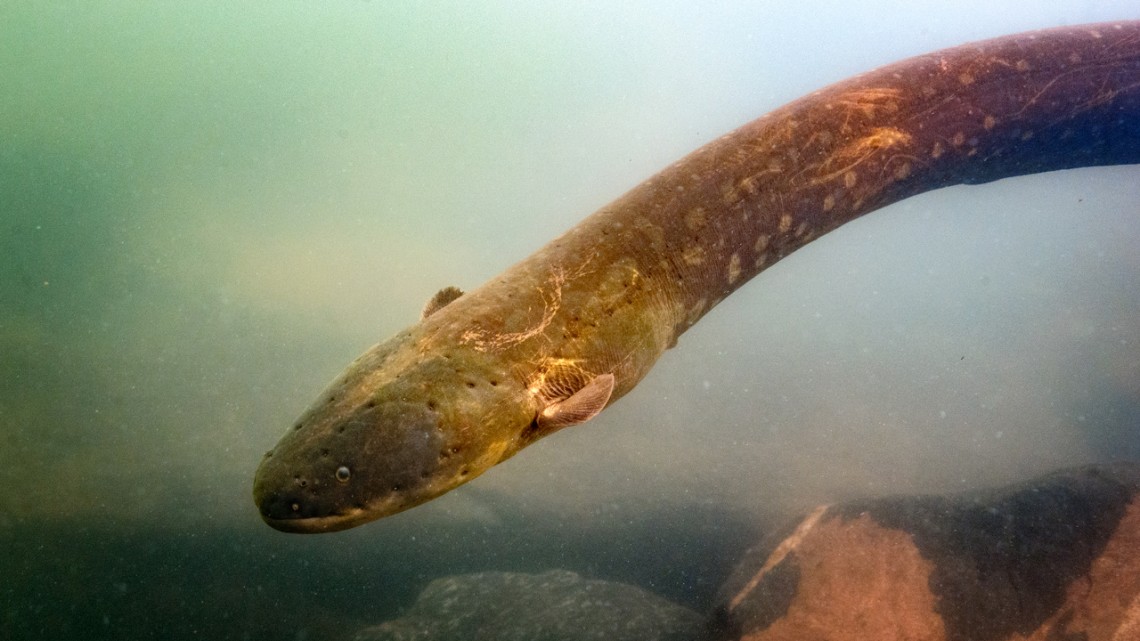
Electrophorus voltai in the Xingu River.
Scientists shocked to discover two new species of electric eel
By Krishna Ramanujan
An international team of scientists has discovered two new species of electric eel, one of which delivers 860 volts; the highest level of electricity generated by any living creature.
“Eight hundred and sixty volts is an incredible output of electricity for an animal. Our electric plug points are 110 volts,” said Casey Dillman, curator of fishes, amphibians and reptiles at the Cornell University Museum of Vertebrates and a co-author of a study published Sept. 10 in Nature Communications describing the discoveries.
The two new species are named Electrophorus varii and E. voltai, the latter generates the massive charge, which is quite a bit more than the 650 volts recorded from the third, and longest known, species, E. electricus; first described by zoologist Carolus Linnaeus 250 years ago. Since then, it was mostly assumed that E. electricus was the only species that existed – and that it was widely distributed across Greater Amazonia.
The researchers wanted to determine whether only one species of electric eel occurred throughout the vast geographic area of the Amazon basin and the more northerly Guiana shield. To test the idea of a single widespread species, the team collected 107 new specimens from a network of collaborators throughout South America and Europe. The three species are very similar in appearance, and thanks to technological advances that provided new genetic, morphological and ecological data, the team identified the two new species.
“The genomes told us there was more than one species and when we went back to the natural history collections [the physical specimens in museums] to examine them we were able to find character differences that distinguished these species,” Dillman said.
E. electricus is restricted to the Guiana shield; E. voltai occurs in generally north-flowing rivers of the Brazilian shield and south-flowing rivers of the Guiana shield, while E. varii lives in the lowland floodplains and upland systems of the Amazon Basin.
All three species have a Sach’s organ, for low voltage electric discharge, and a Hunter’s organ, which generates high voltage. The Sach’s organ emits a weak charge that eels use for communication and for electrolocation, to sense in murky waters. The Hunter’s organ delivers a big blow and facilitates hunting, capturing prey and defense.
Both E. electricus and E. voltai live in faster-moving water with fewer dissolved ions and minerals. And both have stronger electric discharges than E. varii (around 150 volts), which lives in lowland waters with more dissolved particles, making the water more conductive.
Of E. voltai, Dillman said: “Eight hundred sixty volts is so high. I suspect that in order to get the same reaction from the fishes they are going to eat, they have to have this higher voltage because the water is less conductive. ” This paper is part of a larger project to study the weakly electric fishes of the Order Gymnotiformes, which are part of a large group of freshwater fishes called Otophysa that comprises nearly 8,000 species.
C. David de Santana (a researcher in the Department of Vertebrate Zoology at the National Museum of Natural History in Washington, D.C. and lead author of the study) and Dillman received a five-year, $1 milliongrant from São Paulo Research Foundation/Smithsonian Institution to revise, update and discover the diversity of Gymnotiformes. One goal of the grant is to collect samples from eight areas in the Amazon basin that have not been previously inventoried.
“On the very first trip, over two weeks out in the field, some 400 species were collected, and of these about 40 species are new to science,” Dillman said. “There is a lot of diversity and not just in the Gymnotiformes but across the fish tree of life. We’re really excited about what’s coming down the pike with respect to this larger project.”
Media Contact
Get Cornell news delivered right to your inbox.
Subscribe

